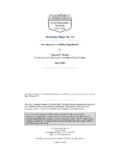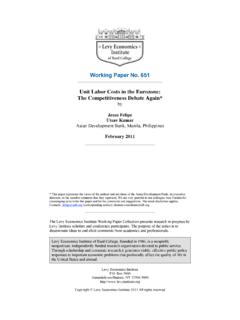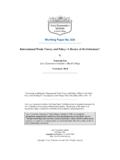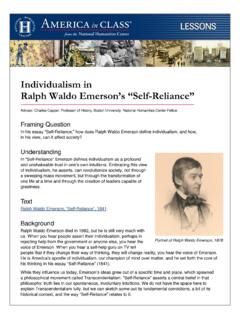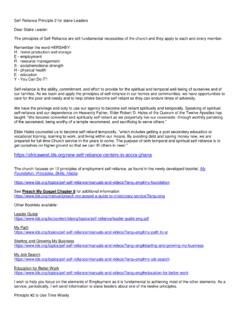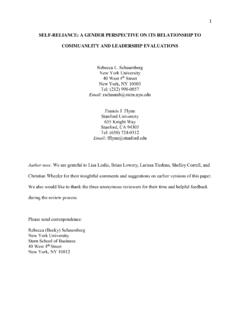Transcription of Self-reliance and Poverty - Levy Economics Institute
1 No. 46A, November 1998 Self-reliance and Poverty Robert Haveman and Andrew Bershadker In the current political and social climate, with its call for Self-reliance as the means by which families andindividuals should support themselves, the official Poverty indicator may be measuring the size of apopulation that is of less interest to policymakers than in past years. We present here an alternative measure ofpoverty for the United States population that is based on a family's capacity for generating income rather thanon its actual money income. This measure, called net earnings capacity (NEC), rests on a concept ofself- reliance and is used to determine the size of the population that is unable to be self -reliant. The Official Measure of Poverty The United States was one of the first countries to establish an official definition of Poverty , and the definition,developed over 30 years ago, has remained largely unchanged.
2 Based on an economist's concept of "incomepoverty," comparing cash income to an assessment of income needs, it has been used to track the nation'spoverty rate and the characteristics of people identified as poor (Fisher 1992; Ruggles 1990). The official measure identifies poor families and the individuals living in them by comparing two numbers: thecurrent annual cash income of the family unit and an estimate of the income necessary for a family of aparticular size and composition to meet a minimum level of consumption. This second number is the family's" Poverty threshold" or " Poverty line." If the income of the family does not exceed its Poverty line, the family isdefined as "poor." The nation's " Poverty rate" is the percentage of its population who live in poor families, sodefined.
3 The official measure is open to many criticisms, both conceptual and practical. One important reason to bedissatisfied with it is that it does not measure permanent characteristics of a family; it relies on a single year ofcash income of a family, while for many families annual income fluctuates. Unemployment, layoffs, thedecision to undertake mid-career training or to change jobs, health considerations, and especially income flowsfrom self -employment may all cause the money income of a household to change substantially from one yearto the next. In recent years some policymakers, reflecting the changing sentiments of many citizens, have called intoquestion the basic concept on which the official measure rests and the policy approaches that follow from the rate measures, so the discussion goes, is how short of income families are (in any given year) and thepolicy that follows from that measure is supplementing income through welfare and other transfers.
4 However,some have argued that government income support has created a dysfunctional social class that generates morepoverty because people become dependent on that support. Having some people with low cash income is notthe fundamental problem; rather the problem is having a number of people who are not self -reliant. In this view,basing policy on a Poverty measure that rests on income realizations can only mean that public support mustalways increase in order to compensate for the decrease in individual effort it creates. Given the judgment that people need to rely on their own energies and resources, it is interesting to ask thefollowing questions: What if there are people who do not have the capability to make it on their own in ourmarket society? What collective responsibility does the nation have to them?
5 One option for advocates ofself- reliance is to consider what can be done to increase the ability of people who are not now economicallyindependent to become so. How can public policy cope with a population unable to be self -reliant, whatinstruments are available, and which are the most cost-effective? An Alternative Poverty Concept and Measure: Net Earnings Capacity What sort of Poverty measure might be relevant to those who place primary emphasis on Self-reliance as asocial objective? No measure consistent with this concern now exists. If one were to design such a measure, theobjective would be to identify the size and composition of the population who cannot be self -reliant and thepatterns of change in the size and composition of this population. We propose a measure that reflects afamily's ability to achieve economic independence, that is, to attain a minimum level of living through the use ofits own capabilities.
6 The main points on which this measure is based are as follows:1 Net earnings capacity is an indicator of the capability of a family to generate an income stream that canbe used for meeting needs. It reflects the full-capacity (full-time, full-year) earnings capability of afamily. Full-time, full-year work is assumed to be the working time of people (age 18 to 65) who are fullyusing their human capital. Values greater or less than this amount could be used, but we accept it as asocially determined norm of full employment. Adjustments are made for illness, disability, and other characteristics related to long-rununemployability and reduced earnings capacity in order to obtain a more realistic estimate of thepotential value of an individual's human capital or gross earnings capacity (GEC).
7 2 Child care costs associated with full-capacity work are subtracted from the GEC to arrive at anestimate of a family's net earnings capacity (NEC). A family with an NEC below the official Poverty line is defined as living in NEC Poverty . A familywith an NEC above the Poverty line is considered to be capable of being self -reliant. NEC Poverty and Official Poverty Rates We use annual data from the March Current Population Survey to estimate the rate of NEC Poverty forfamilies headed by a working-age person in the United States from 1975 to 1995. Our estimates of the overallprevalence of both NEC Poverty and official Poverty for 1975 to 1995 are shown in Table 1. While the official Poverty rate over the period ranged from about 10 to 14 percent, the NEC Poverty rate rangedfrom about 6 to 11 percent.
8 The primary factors that account for this difference are (1) the counting of transferincome (done in the official measure but not in the NEC measure), (2) the less than full-time, full-year work ofmany working-age adults (which affects the official Poverty measure), and (3) the adjustment for child carecosts (which affects NEC Poverty but not official Poverty ). The official Poverty rate is more sensitive to business cycle fluctuations than the NEC rate. While the officialpoverty rate rose nearly 40 percent during the recession of the early 1980s, the NEC Poverty rate rose less thanhalf of this amount. Given that the NEC measure reflects longer-term (or permanent) earnings potential asopposed to the shorter-term actual income amount reflected in the official measure, the closer tie betweencurrent labor market conditions and the official Poverty rate is expected.
9 Table 1 Percent of Individuals in NEC Poverty and Official Poverty , 1975 to 1995 NEC Poverty Official Poverty 1975-19771993-1995 AverageAnnualGrowth(Percent)1975-1977199 3-1995 AverageAnnualGrowth(Percent)All of head White Other of head Male of head Less than high school High school graduate Some college College graduate with no children All Married couples Single men Single women with children All Married couples Single Single Single mothers on Single mothers not on Note: The growth rate is calculated using the average 1975-1977 and 1993-1995 Poverty rates and assuming 18 years ofgrowth.
10 Source: Bureau of the Census, March Current Population Survey data files. NEC Poverty has grown at a substantially faster rate than has official Poverty . Over the 1975 to 1995 periodthe prevalence of official Poverty grew by about one-third, with an average annual growth rate of Poverty grew by nearly 185 percent, with an annual growth rate of percent, or twice the growth rate ofthe official Poverty . This growth in economic inadequacy in terms of both current income and earningspotential is troubling when one considers the growth in affluence in the United States over the period;inflation-adjusted disposable income per capita increased from $13,400 to $18,900 (1992 dollars), an increaseof over 40 percent. The overall Poverty trends hide a variety of patterns of Poverty growth among subgroups of the For example, the growth in NEC Poverty among the population groups shown in Table 1 rangesfrom percent per year (for individuals living in families headed by a female) to over percent per year(for individuals living in families headed by someone with some college).

